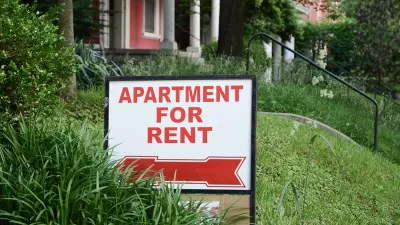The common metric for measuring housing affordability—whether households pay more than 30 percent of their income on shelter—has its downsides. Looking at residual income offers more precision in some respects.

A working paper from Harvard's Joint Center for Housing Studies examines housing affordability on the basis on residual income, a metric that's more sensitive to demographic differences in circumstance than the usual 30-percent standard. Chris Herbert and Daniel McCue write, "This alternative approach improves on the simple 30-percent standard by estimating the cost of 'everything else' as a function of the number and ages of all household members. It then estimates how much income would be available to pay for housing if those other costs were fully covered."
"In this framework," they go on, "the share of income that can be devoted to housing is not a single standard, but rather varies depending on both the size and composition of the household and the level of household income." That means a well-paid young professional may be devoting 50 percent of his or her income to rent, but still have more than enough for necessary and discretionary expenses, even in a high-cost city. The same would likely not be the case for someone earning low wages, or for a household with lots of kids.
The paper finds that compared to the residual income measure, the 30-percent standard often overstates affordability problems in high-cost markets, for high-income and smaller households. But overall levels of affordability remain similar in both models.
In a Slate article expanding on the topic, Henry Grabar writes that the 30-percent model "can't tell the difference between places where rents are growing too fast and those where incomes are growing too slowly—making it hard to tell if the problem is a housing shortage or the more entrenched issue of poverty and low wages."
FULL STORY: Is There a Better Way to Measure Housing Affordability?

Maui's Vacation Rental Debate Turns Ugly
Verbal attacks, misinformation campaigns and fistfights plague a high-stakes debate to convert thousands of vacation rentals into long-term housing.

Planetizen Federal Action Tracker
A weekly monitor of how Trump’s orders and actions are impacting planners and planning in America.

In Urban Planning, AI Prompting Could be the New Design Thinking
Creativity has long been key to great urban design. What if we see AI as our new creative partner?

King County Supportive Housing Program Offers Hope for Unhoused Residents
The county is taking a ‘Housing First’ approach that prioritizes getting people into housing, then offering wraparound supportive services.

Researchers Use AI to Get Clearer Picture of US Housing
Analysts are using artificial intelligence to supercharge their research by allowing them to comb through data faster. Though these AI tools can be error prone, they save time and housing researchers are optimistic about the future.

Making Shared Micromobility More Inclusive
Cities and shared mobility system operators can do more to include people with disabilities in planning and operations, per a new report.
Urban Design for Planners 1: Software Tools
This six-course series explores essential urban design concepts using open source software and equips planners with the tools they need to participate fully in the urban design process.
Planning for Universal Design
Learn the tools for implementing Universal Design in planning regulations.
planning NEXT
Appalachian Highlands Housing Partners
Mpact (founded as Rail~Volution)
City of Camden Redevelopment Agency
City of Astoria
City of Portland
City of Laramie





























